Marketing Strategy in Contest: Vifor Pharma Market Analysis
VerifiedAdded on 2022/09/26
|16
|3237
|18
Report
AI Summary
This report provides a comprehensive analysis of the Singapore medical industry, focusing on Vifor Pharma and its market expansion strategies. It begins with an executive summary and a table of contents, followed by an introduction outlining the report's objectives. The report delves into competitive analysis, exploring the scope and industry competition, the number of players and their relative size, and the positioning of competitors like Raffles Medical Group, GlaxoSmithKline, and others. It examines product and service differentiation, dominant economic features, market size, growth rate, and the industry's life-cycle stage. The core of the analysis involves a PESTEL analysis, considering political, economic, social, technological, legal, and environmental factors affecting the healthcare market. Furthermore, a Porter’s Five Forces analysis assesses rivalry among competitors, the bargaining power of consumers and suppliers, and the threat of new entrants and substitutes. The report concludes by identifying key success factors for the healthcare market in Singapore, offering insights into market sustainability and profitability, and includes references and an appendix for additional information. The report aims to inform Vifor Pharma's marketing plan for the Singapore market, providing a detailed overview of the industry's landscape.
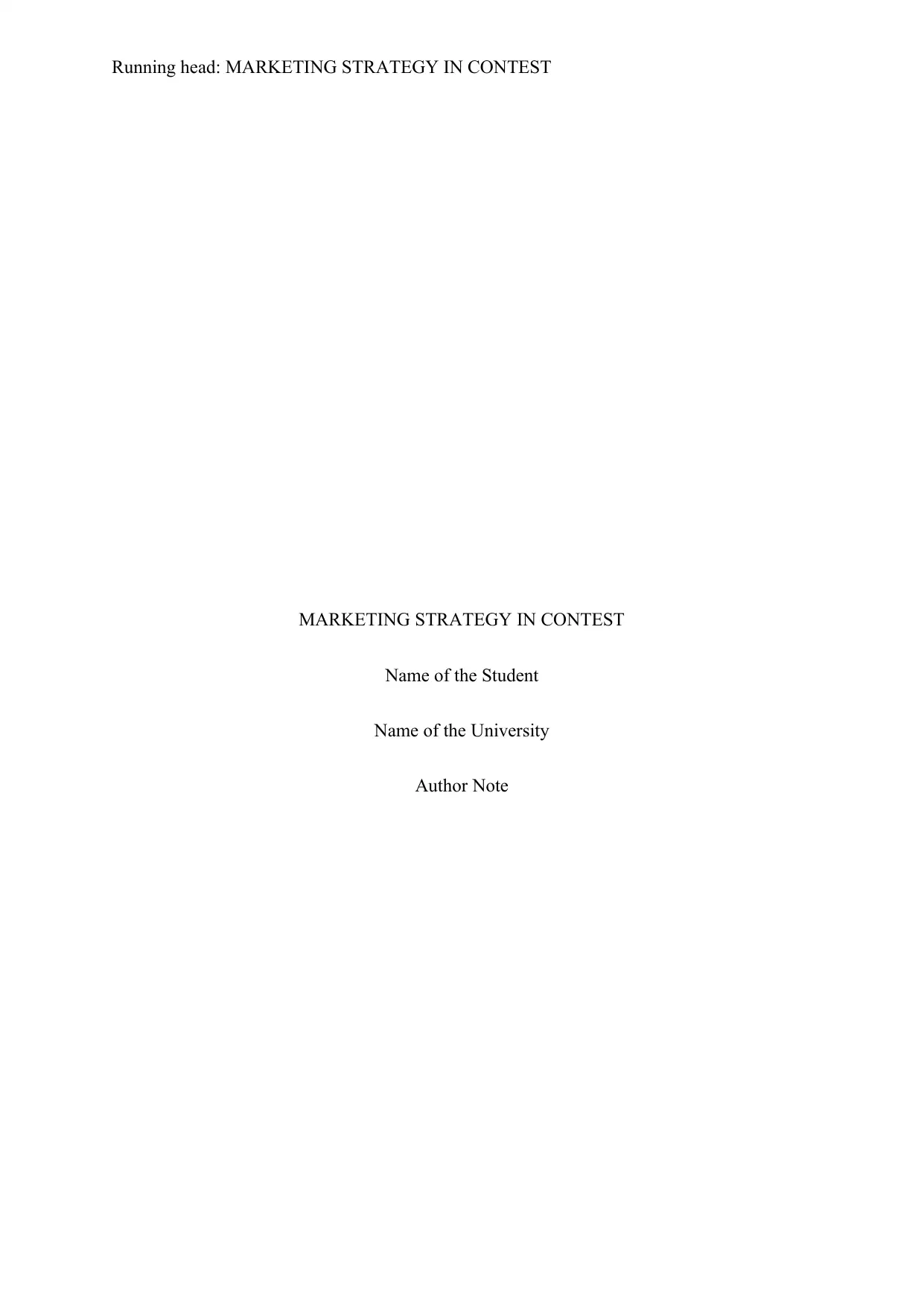
Running head: MARKETING STRATEGY IN CONTEST
MARKETING STRATEGY IN CONTEST
Name of the Student
Name of the University
Author Note
MARKETING STRATEGY IN CONTEST
Name of the Student
Name of the University
Author Note
Paraphrase This Document
Need a fresh take? Get an instant paraphrase of this document with our AI Paraphraser
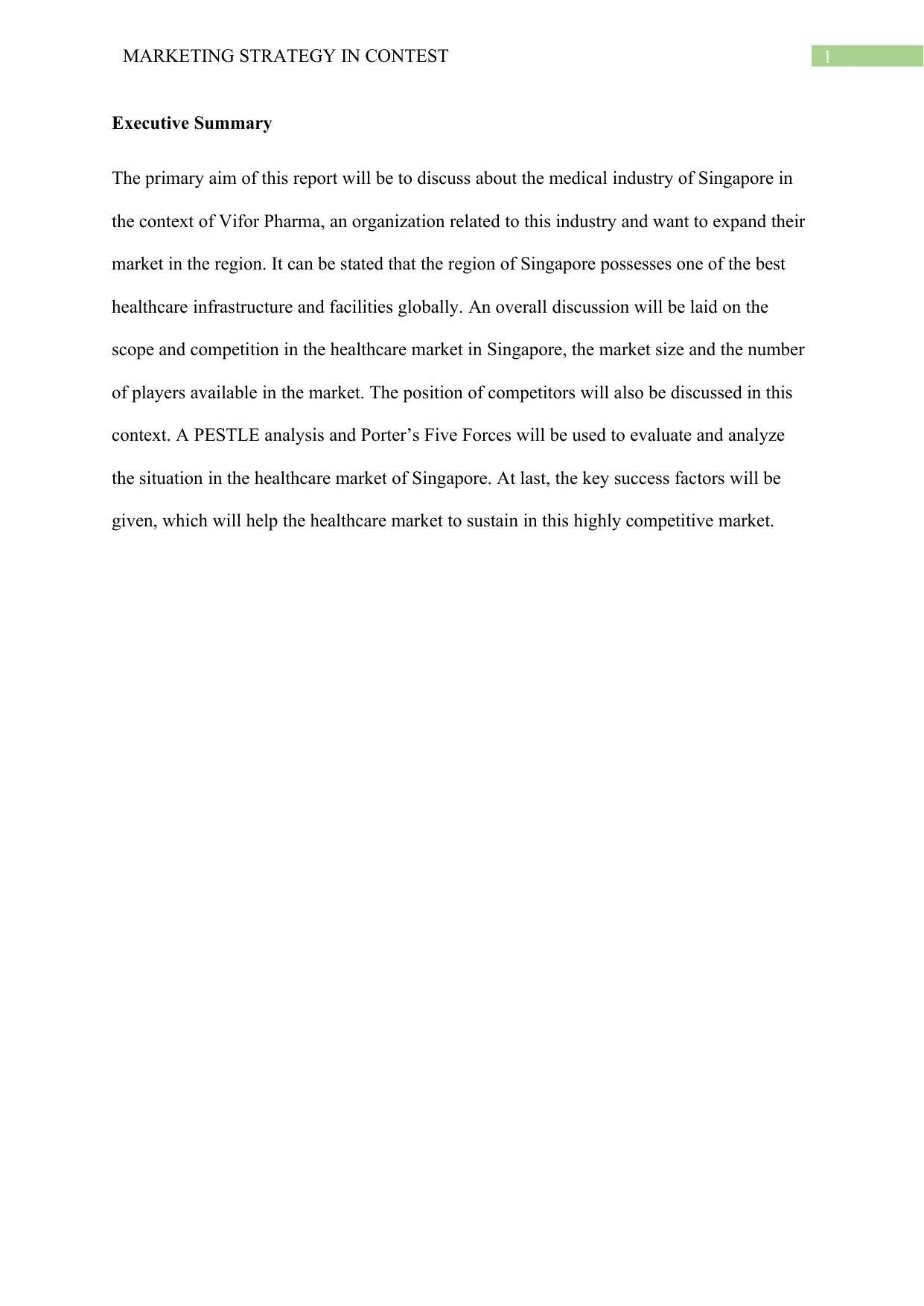
1MARKETING STRATEGY IN CONTEST
Executive Summary
The primary aim of this report will be to discuss about the medical industry of Singapore in
the context of Vifor Pharma, an organization related to this industry and want to expand their
market in the region. It can be stated that the region of Singapore possesses one of the best
healthcare infrastructure and facilities globally. An overall discussion will be laid on the
scope and competition in the healthcare market in Singapore, the market size and the number
of players available in the market. The position of competitors will also be discussed in this
context. A PESTLE analysis and Porter’s Five Forces will be used to evaluate and analyze
the situation in the healthcare market of Singapore. At last, the key success factors will be
given, which will help the healthcare market to sustain in this highly competitive market.
Executive Summary
The primary aim of this report will be to discuss about the medical industry of Singapore in
the context of Vifor Pharma, an organization related to this industry and want to expand their
market in the region. It can be stated that the region of Singapore possesses one of the best
healthcare infrastructure and facilities globally. An overall discussion will be laid on the
scope and competition in the healthcare market in Singapore, the market size and the number
of players available in the market. The position of competitors will also be discussed in this
context. A PESTLE analysis and Porter’s Five Forces will be used to evaluate and analyze
the situation in the healthcare market of Singapore. At last, the key success factors will be
given, which will help the healthcare market to sustain in this highly competitive market.
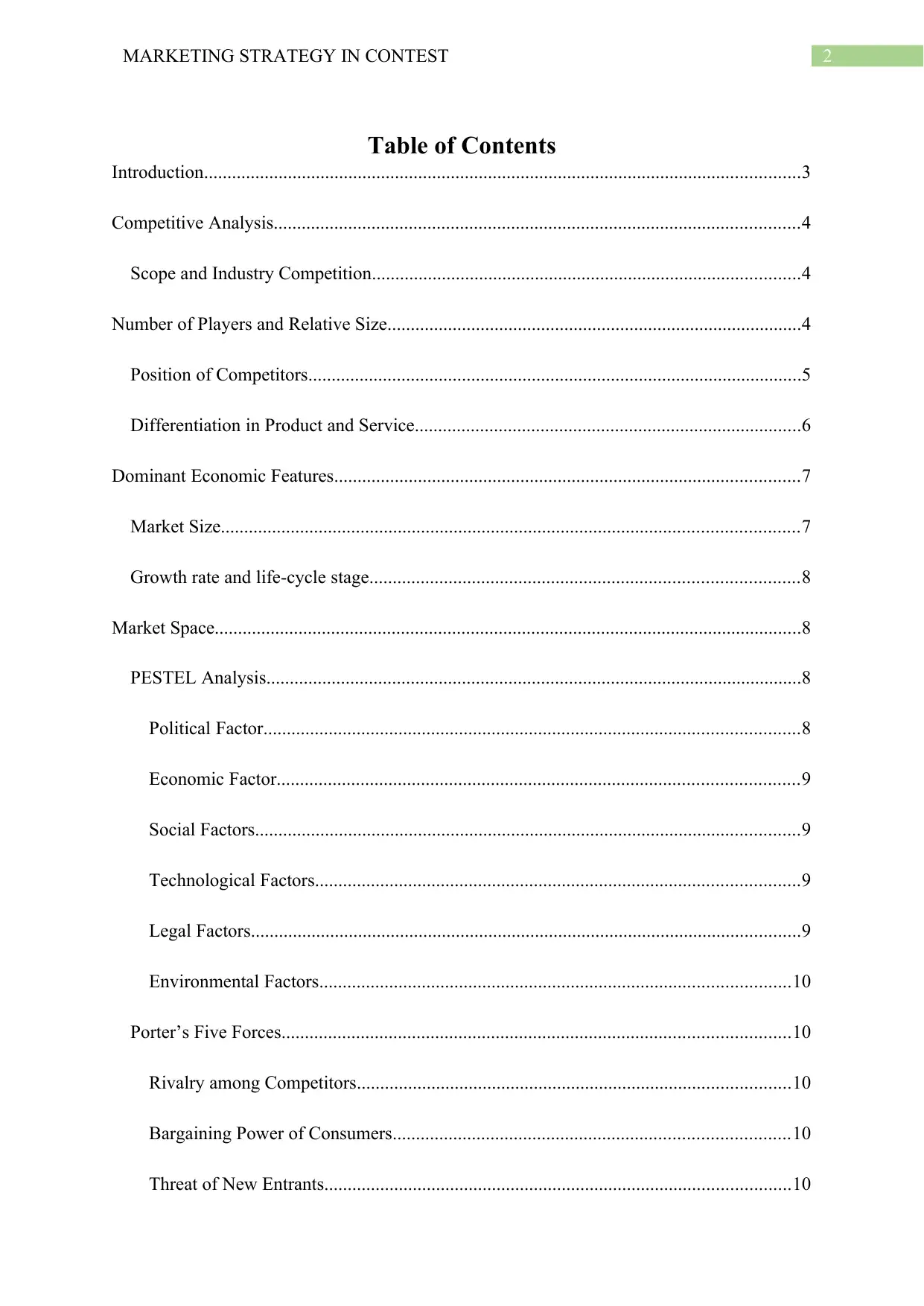
2MARKETING STRATEGY IN CONTEST
Table of Contents
Introduction................................................................................................................................3
Competitive Analysis.................................................................................................................4
Scope and Industry Competition............................................................................................4
Number of Players and Relative Size.........................................................................................4
Position of Competitors..........................................................................................................5
Differentiation in Product and Service...................................................................................6
Dominant Economic Features....................................................................................................7
Market Size............................................................................................................................7
Growth rate and life-cycle stage............................................................................................8
Market Space..............................................................................................................................8
PESTEL Analysis...................................................................................................................8
Political Factor...................................................................................................................8
Economic Factor................................................................................................................9
Social Factors.....................................................................................................................9
Technological Factors........................................................................................................9
Legal Factors......................................................................................................................9
Environmental Factors.....................................................................................................10
Porter’s Five Forces.............................................................................................................10
Rivalry among Competitors.............................................................................................10
Bargaining Power of Consumers.....................................................................................10
Threat of New Entrants....................................................................................................10
Table of Contents
Introduction................................................................................................................................3
Competitive Analysis.................................................................................................................4
Scope and Industry Competition............................................................................................4
Number of Players and Relative Size.........................................................................................4
Position of Competitors..........................................................................................................5
Differentiation in Product and Service...................................................................................6
Dominant Economic Features....................................................................................................7
Market Size............................................................................................................................7
Growth rate and life-cycle stage............................................................................................8
Market Space..............................................................................................................................8
PESTEL Analysis...................................................................................................................8
Political Factor...................................................................................................................8
Economic Factor................................................................................................................9
Social Factors.....................................................................................................................9
Technological Factors........................................................................................................9
Legal Factors......................................................................................................................9
Environmental Factors.....................................................................................................10
Porter’s Five Forces.............................................................................................................10
Rivalry among Competitors.............................................................................................10
Bargaining Power of Consumers.....................................................................................10
Threat of New Entrants....................................................................................................10
⊘ This is a preview!⊘
Do you want full access?
Subscribe today to unlock all pages.

Trusted by 1+ million students worldwide
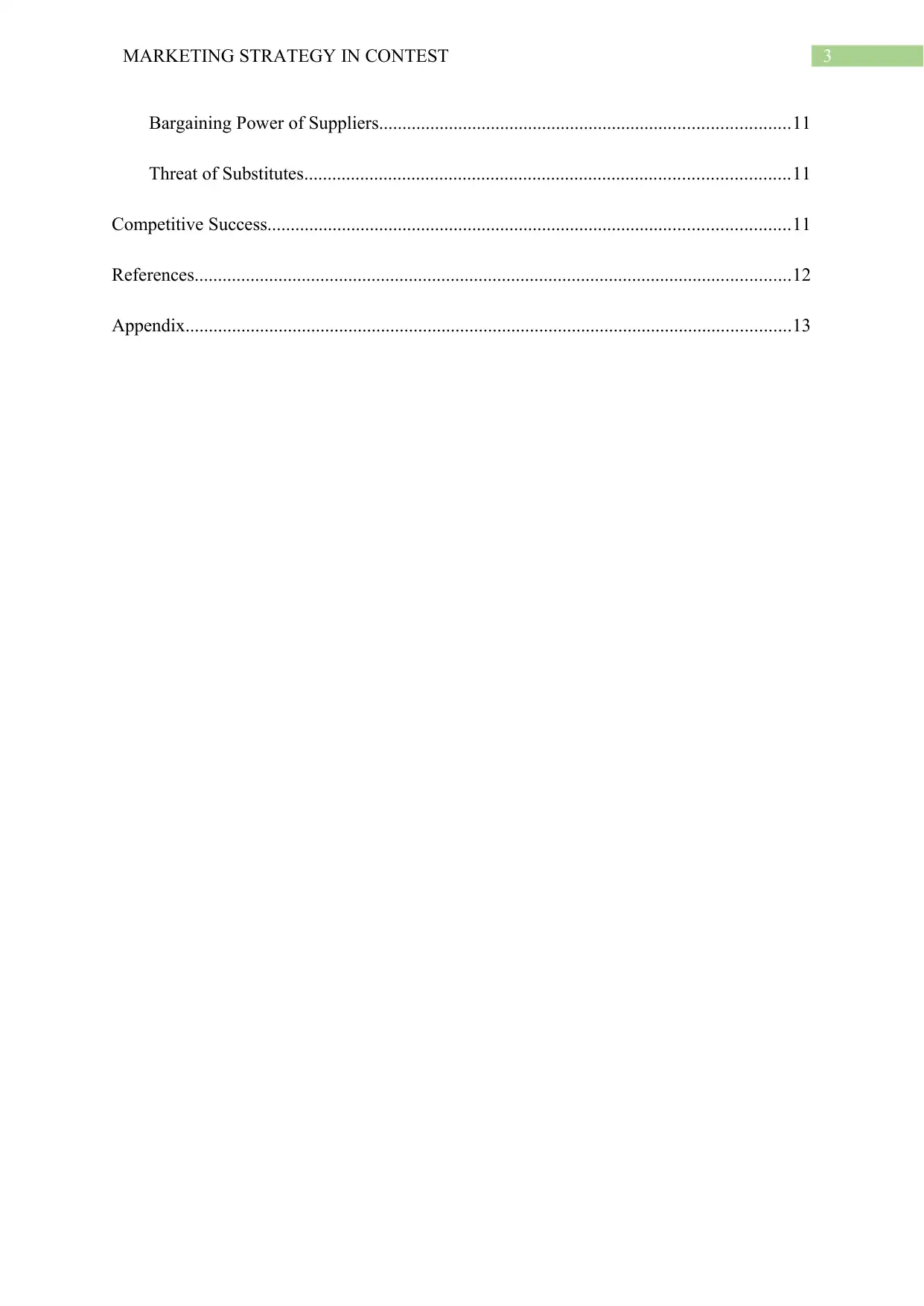
3MARKETING STRATEGY IN CONTEST
Bargaining Power of Suppliers........................................................................................11
Threat of Substitutes........................................................................................................11
Competitive Success................................................................................................................11
References................................................................................................................................12
Appendix..................................................................................................................................13
Bargaining Power of Suppliers........................................................................................11
Threat of Substitutes........................................................................................................11
Competitive Success................................................................................................................11
References................................................................................................................................12
Appendix..................................................................................................................................13
Paraphrase This Document
Need a fresh take? Get an instant paraphrase of this document with our AI Paraphraser
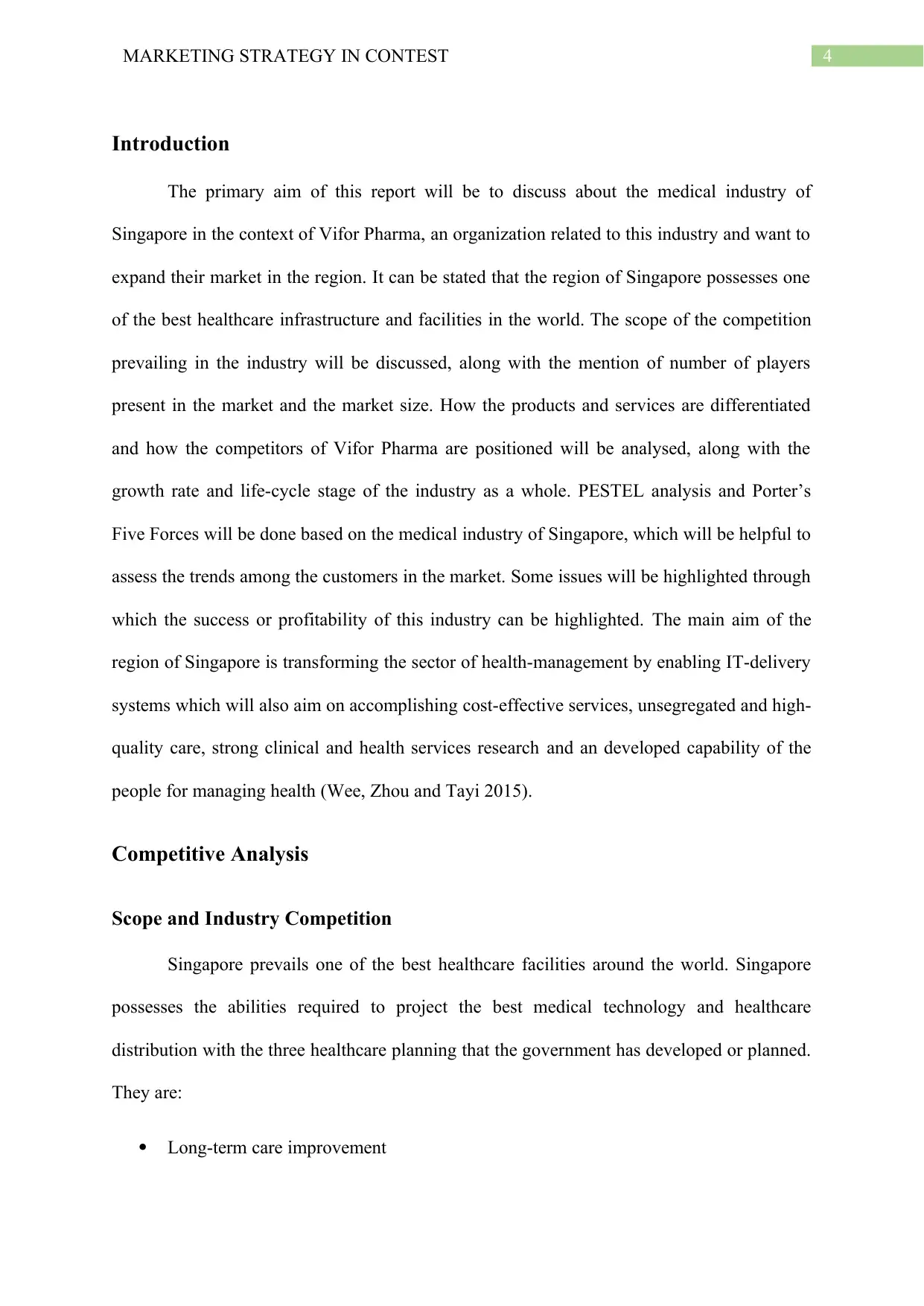
4MARKETING STRATEGY IN CONTEST
Introduction
The primary aim of this report will be to discuss about the medical industry of
Singapore in the context of Vifor Pharma, an organization related to this industry and want to
expand their market in the region. It can be stated that the region of Singapore possesses one
of the best healthcare infrastructure and facilities in the world. The scope of the competition
prevailing in the industry will be discussed, along with the mention of number of players
present in the market and the market size. How the products and services are differentiated
and how the competitors of Vifor Pharma are positioned will be analysed, along with the
growth rate and life-cycle stage of the industry as a whole. PESTEL analysis and Porter’s
Five Forces will be done based on the medical industry of Singapore, which will be helpful to
assess the trends among the customers in the market. Some issues will be highlighted through
which the success or profitability of this industry can be highlighted. The main aim of the
region of Singapore is transforming the sector of health-management by enabling IT-delivery
systems which will also aim on accomplishing cost-effective services, unsegregated and high-
quality care, strong clinical and health services research and an developed capability of the
people for managing health (Wee, Zhou and Tayi 2015).
Competitive Analysis
Scope and Industry Competition
Singapore prevails one of the best healthcare facilities around the world. Singapore
possesses the abilities required to project the best medical technology and healthcare
distribution with the three healthcare planning that the government has developed or planned.
They are:
Long-term care improvement
Introduction
The primary aim of this report will be to discuss about the medical industry of
Singapore in the context of Vifor Pharma, an organization related to this industry and want to
expand their market in the region. It can be stated that the region of Singapore possesses one
of the best healthcare infrastructure and facilities in the world. The scope of the competition
prevailing in the industry will be discussed, along with the mention of number of players
present in the market and the market size. How the products and services are differentiated
and how the competitors of Vifor Pharma are positioned will be analysed, along with the
growth rate and life-cycle stage of the industry as a whole. PESTEL analysis and Porter’s
Five Forces will be done based on the medical industry of Singapore, which will be helpful to
assess the trends among the customers in the market. Some issues will be highlighted through
which the success or profitability of this industry can be highlighted. The main aim of the
region of Singapore is transforming the sector of health-management by enabling IT-delivery
systems which will also aim on accomplishing cost-effective services, unsegregated and high-
quality care, strong clinical and health services research and an developed capability of the
people for managing health (Wee, Zhou and Tayi 2015).
Competitive Analysis
Scope and Industry Competition
Singapore prevails one of the best healthcare facilities around the world. Singapore
possesses the abilities required to project the best medical technology and healthcare
distribution with the three healthcare planning that the government has developed or planned.
They are:
Long-term care improvement
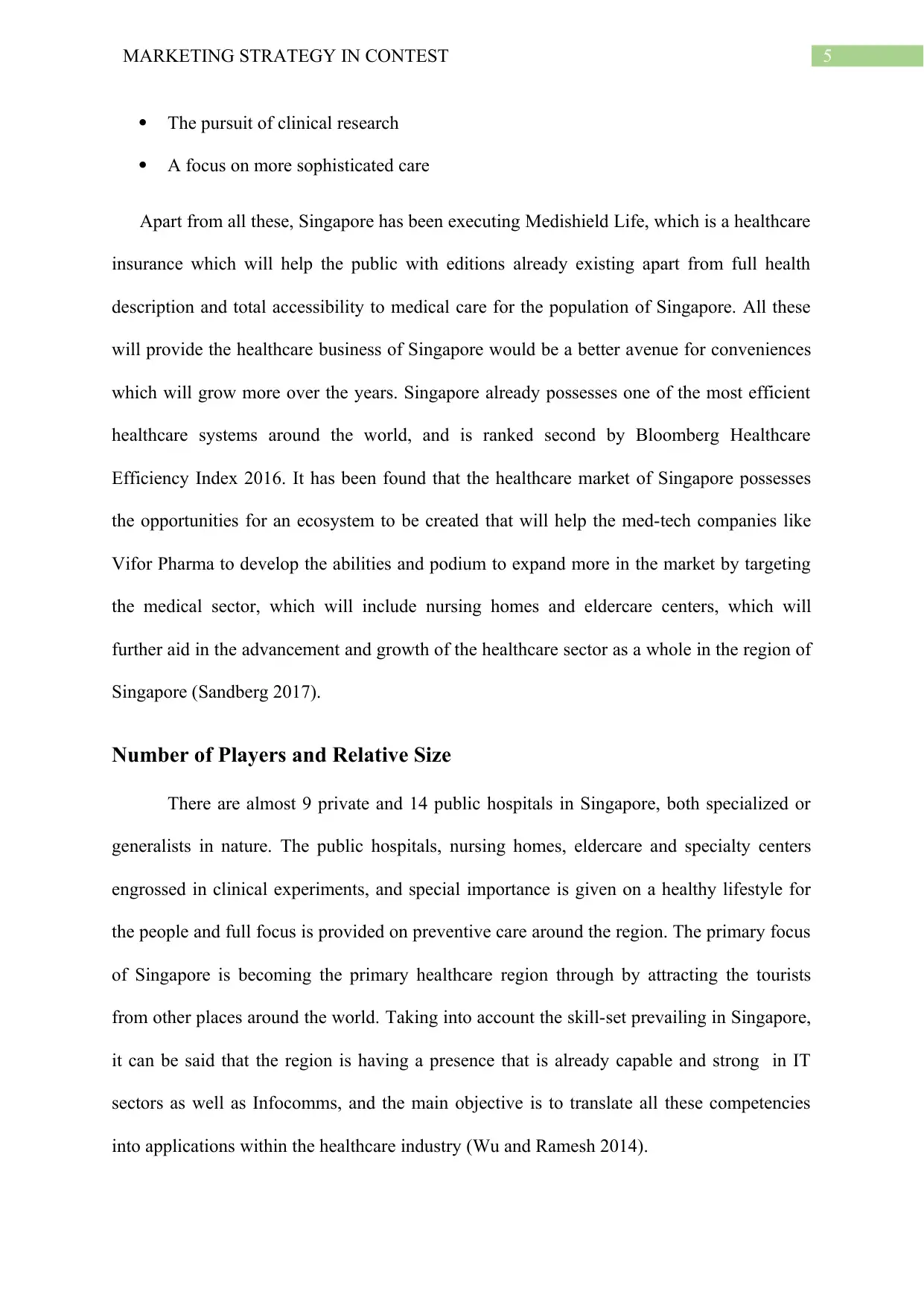
5MARKETING STRATEGY IN CONTEST
The pursuit of clinical research
A focus on more sophisticated care
Apart from all these, Singapore has been executing Medishield Life, which is a healthcare
insurance which will help the public with editions already existing apart from full health
description and total accessibility to medical care for the population of Singapore. All these
will provide the healthcare business of Singapore would be a better avenue for conveniences
which will grow more over the years. Singapore already possesses one of the most efficient
healthcare systems around the world, and is ranked second by Bloomberg Healthcare
Efficiency Index 2016. It has been found that the healthcare market of Singapore possesses
the opportunities for an ecosystem to be created that will help the med-tech companies like
Vifor Pharma to develop the abilities and podium to expand more in the market by targeting
the medical sector, which will include nursing homes and eldercare centers, which will
further aid in the advancement and growth of the healthcare sector as a whole in the region of
Singapore (Sandberg 2017).
Number of Players and Relative Size
There are almost 9 private and 14 public hospitals in Singapore, both specialized or
generalists in nature. The public hospitals, nursing homes, eldercare and specialty centers
engrossed in clinical experiments, and special importance is given on a healthy lifestyle for
the people and full focus is provided on preventive care around the region. The primary focus
of Singapore is becoming the primary healthcare region through by attracting the tourists
from other places around the world. Taking into account the skill-set prevailing in Singapore,
it can be said that the region is having a presence that is already capable and strong in IT
sectors as well as Infocomms, and the main objective is to translate all these competencies
into applications within the healthcare industry (Wu and Ramesh 2014).
The pursuit of clinical research
A focus on more sophisticated care
Apart from all these, Singapore has been executing Medishield Life, which is a healthcare
insurance which will help the public with editions already existing apart from full health
description and total accessibility to medical care for the population of Singapore. All these
will provide the healthcare business of Singapore would be a better avenue for conveniences
which will grow more over the years. Singapore already possesses one of the most efficient
healthcare systems around the world, and is ranked second by Bloomberg Healthcare
Efficiency Index 2016. It has been found that the healthcare market of Singapore possesses
the opportunities for an ecosystem to be created that will help the med-tech companies like
Vifor Pharma to develop the abilities and podium to expand more in the market by targeting
the medical sector, which will include nursing homes and eldercare centers, which will
further aid in the advancement and growth of the healthcare sector as a whole in the region of
Singapore (Sandberg 2017).
Number of Players and Relative Size
There are almost 9 private and 14 public hospitals in Singapore, both specialized or
generalists in nature. The public hospitals, nursing homes, eldercare and specialty centers
engrossed in clinical experiments, and special importance is given on a healthy lifestyle for
the people and full focus is provided on preventive care around the region. The primary focus
of Singapore is becoming the primary healthcare region through by attracting the tourists
from other places around the world. Taking into account the skill-set prevailing in Singapore,
it can be said that the region is having a presence that is already capable and strong in IT
sectors as well as Infocomms, and the main objective is to translate all these competencies
into applications within the healthcare industry (Wu and Ramesh 2014).
⊘ This is a preview!⊘
Do you want full access?
Subscribe today to unlock all pages.

Trusted by 1+ million students worldwide
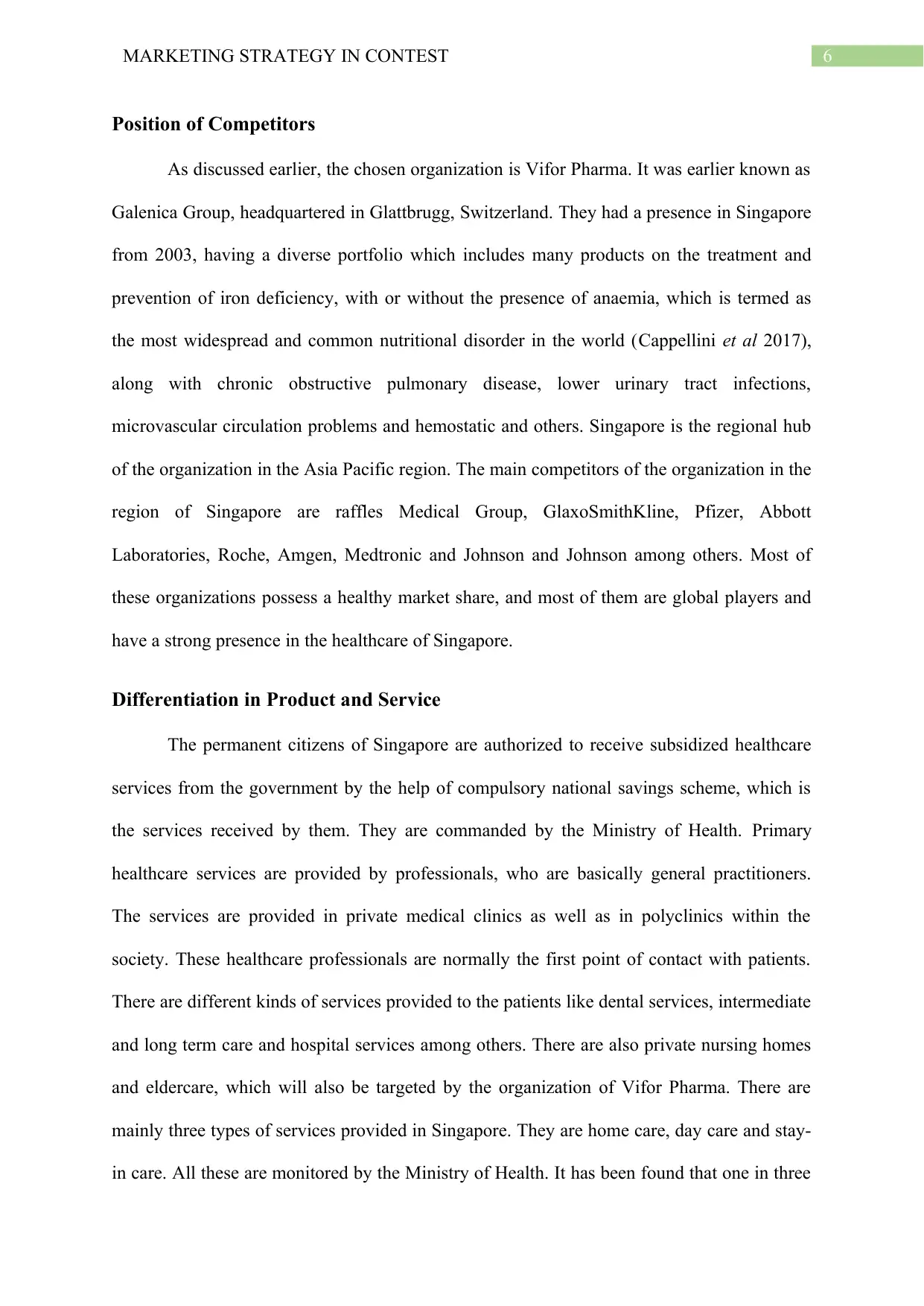
6MARKETING STRATEGY IN CONTEST
Position of Competitors
As discussed earlier, the chosen organization is Vifor Pharma. It was earlier known as
Galenica Group, headquartered in Glattbrugg, Switzerland. They had a presence in Singapore
from 2003, having a diverse portfolio which includes many products on the treatment and
prevention of iron deficiency, with or without the presence of anaemia, which is termed as
the most widespread and common nutritional disorder in the world (Cappellini et al 2017),
along with chronic obstructive pulmonary disease, lower urinary tract infections,
microvascular circulation problems and hemostatic and others. Singapore is the regional hub
of the organization in the Asia Pacific region. The main competitors of the organization in the
region of Singapore are raffles Medical Group, GlaxoSmithKline, Pfizer, Abbott
Laboratories, Roche, Amgen, Medtronic and Johnson and Johnson among others. Most of
these organizations possess a healthy market share, and most of them are global players and
have a strong presence in the healthcare of Singapore.
Differentiation in Product and Service
The permanent citizens of Singapore are authorized to receive subsidized healthcare
services from the government by the help of compulsory national savings scheme, which is
the services received by them. They are commanded by the Ministry of Health. Primary
healthcare services are provided by professionals, who are basically general practitioners.
The services are provided in private medical clinics as well as in polyclinics within the
society. These healthcare professionals are normally the first point of contact with patients.
There are different kinds of services provided to the patients like dental services, intermediate
and long term care and hospital services among others. There are also private nursing homes
and eldercare, which will also be targeted by the organization of Vifor Pharma. There are
mainly three types of services provided in Singapore. They are home care, day care and stay-
in care. All these are monitored by the Ministry of Health. It has been found that one in three
Position of Competitors
As discussed earlier, the chosen organization is Vifor Pharma. It was earlier known as
Galenica Group, headquartered in Glattbrugg, Switzerland. They had a presence in Singapore
from 2003, having a diverse portfolio which includes many products on the treatment and
prevention of iron deficiency, with or without the presence of anaemia, which is termed as
the most widespread and common nutritional disorder in the world (Cappellini et al 2017),
along with chronic obstructive pulmonary disease, lower urinary tract infections,
microvascular circulation problems and hemostatic and others. Singapore is the regional hub
of the organization in the Asia Pacific region. The main competitors of the organization in the
region of Singapore are raffles Medical Group, GlaxoSmithKline, Pfizer, Abbott
Laboratories, Roche, Amgen, Medtronic and Johnson and Johnson among others. Most of
these organizations possess a healthy market share, and most of them are global players and
have a strong presence in the healthcare of Singapore.
Differentiation in Product and Service
The permanent citizens of Singapore are authorized to receive subsidized healthcare
services from the government by the help of compulsory national savings scheme, which is
the services received by them. They are commanded by the Ministry of Health. Primary
healthcare services are provided by professionals, who are basically general practitioners.
The services are provided in private medical clinics as well as in polyclinics within the
society. These healthcare professionals are normally the first point of contact with patients.
There are different kinds of services provided to the patients like dental services, intermediate
and long term care and hospital services among others. There are also private nursing homes
and eldercare, which will also be targeted by the organization of Vifor Pharma. There are
mainly three types of services provided in Singapore. They are home care, day care and stay-
in care. All these are monitored by the Ministry of Health. It has been found that one in three
Paraphrase This Document
Need a fresh take? Get an instant paraphrase of this document with our AI Paraphraser
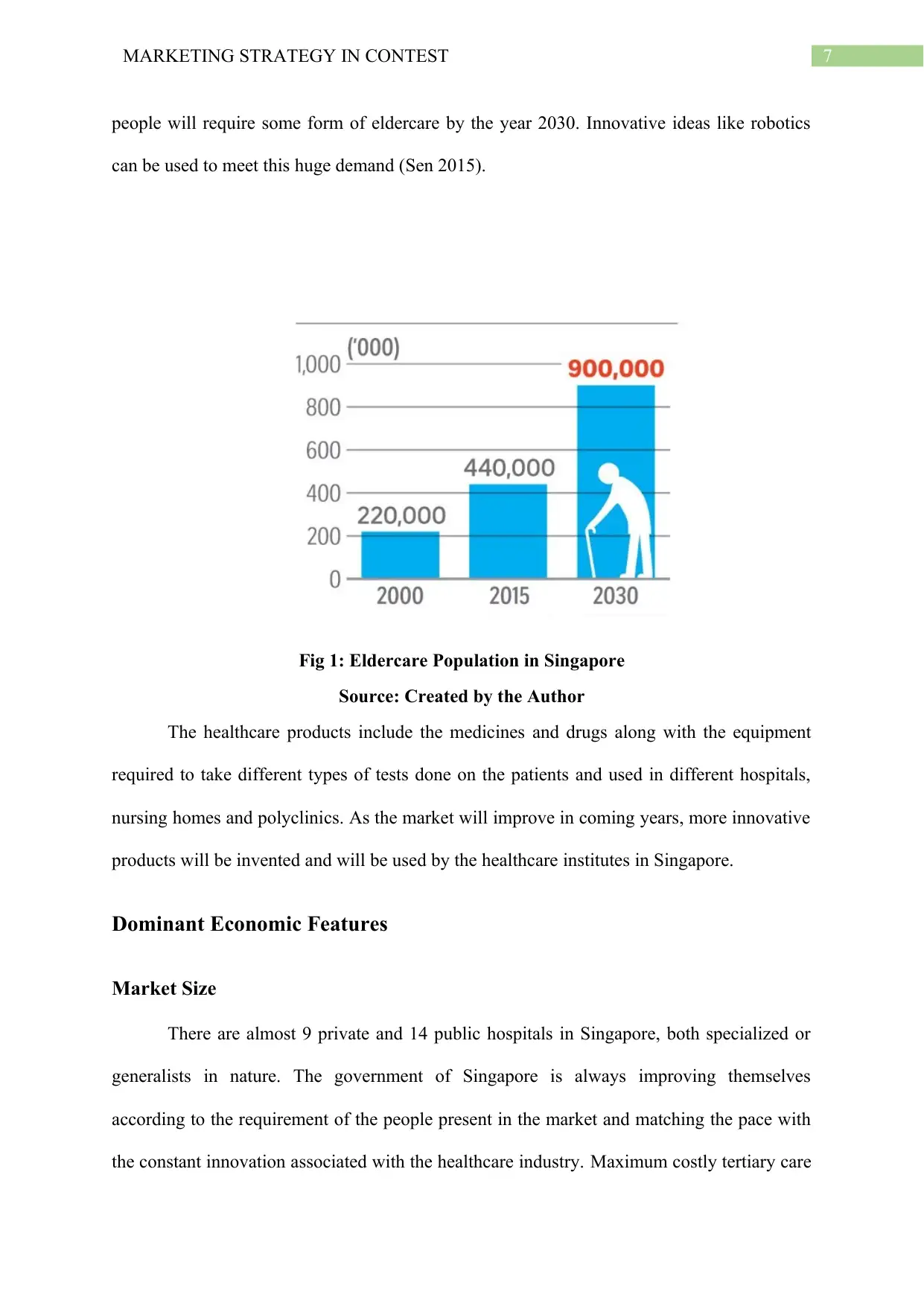
7MARKETING STRATEGY IN CONTEST
people will require some form of eldercare by the year 2030. Innovative ideas like robotics
can be used to meet this huge demand (Sen 2015).
Fig 1: Eldercare Population in Singapore
Source: Created by the Author
The healthcare products include the medicines and drugs along with the equipment
required to take different types of tests done on the patients and used in different hospitals,
nursing homes and polyclinics. As the market will improve in coming years, more innovative
products will be invented and will be used by the healthcare institutes in Singapore.
Dominant Economic Features
Market Size
There are almost 9 private and 14 public hospitals in Singapore, both specialized or
generalists in nature. The government of Singapore is always improving themselves
according to the requirement of the people present in the market and matching the pace with
the constant innovation associated with the healthcare industry. Maximum costly tertiary care
people will require some form of eldercare by the year 2030. Innovative ideas like robotics
can be used to meet this huge demand (Sen 2015).
Fig 1: Eldercare Population in Singapore
Source: Created by the Author
The healthcare products include the medicines and drugs along with the equipment
required to take different types of tests done on the patients and used in different hospitals,
nursing homes and polyclinics. As the market will improve in coming years, more innovative
products will be invented and will be used by the healthcare institutes in Singapore.
Dominant Economic Features
Market Size
There are almost 9 private and 14 public hospitals in Singapore, both specialized or
generalists in nature. The government of Singapore is always improving themselves
according to the requirement of the people present in the market and matching the pace with
the constant innovation associated with the healthcare industry. Maximum costly tertiary care
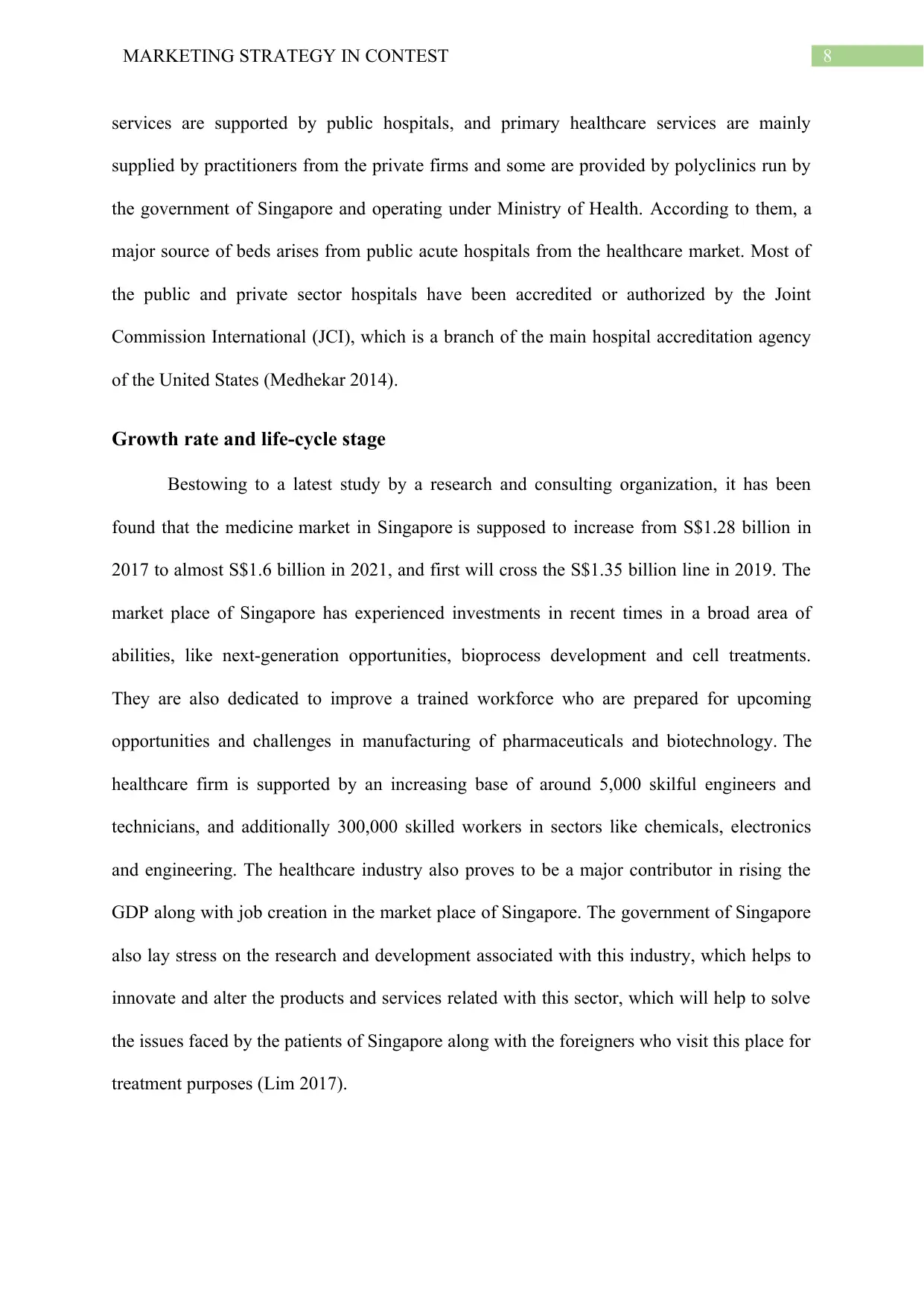
8MARKETING STRATEGY IN CONTEST
services are supported by public hospitals, and primary healthcare services are mainly
supplied by practitioners from the private firms and some are provided by polyclinics run by
the government of Singapore and operating under Ministry of Health. According to them, a
major source of beds arises from public acute hospitals from the healthcare market. Most of
the public and private sector hospitals have been accredited or authorized by the Joint
Commission International (JCI), which is a branch of the main hospital accreditation agency
of the United States (Medhekar 2014).
Growth rate and life-cycle stage
Bestowing to a latest study by a research and consulting organization, it has been
found that the medicine market in Singapore is supposed to increase from S$1.28 billion in
2017 to almost S$1.6 billion in 2021, and first will cross the S$1.35 billion line in 2019. The
market place of Singapore has experienced investments in recent times in a broad area of
abilities, like next-generation opportunities, bioprocess development and cell treatments.
They are also dedicated to improve a trained workforce who are prepared for upcoming
opportunities and challenges in manufacturing of pharmaceuticals and biotechnology. The
healthcare firm is supported by an increasing base of around 5,000 skilful engineers and
technicians, and additionally 300,000 skilled workers in sectors like chemicals, electronics
and engineering. The healthcare industry also proves to be a major contributor in rising the
GDP along with job creation in the market place of Singapore. The government of Singapore
also lay stress on the research and development associated with this industry, which helps to
innovate and alter the products and services related with this sector, which will help to solve
the issues faced by the patients of Singapore along with the foreigners who visit this place for
treatment purposes (Lim 2017).
services are supported by public hospitals, and primary healthcare services are mainly
supplied by practitioners from the private firms and some are provided by polyclinics run by
the government of Singapore and operating under Ministry of Health. According to them, a
major source of beds arises from public acute hospitals from the healthcare market. Most of
the public and private sector hospitals have been accredited or authorized by the Joint
Commission International (JCI), which is a branch of the main hospital accreditation agency
of the United States (Medhekar 2014).
Growth rate and life-cycle stage
Bestowing to a latest study by a research and consulting organization, it has been
found that the medicine market in Singapore is supposed to increase from S$1.28 billion in
2017 to almost S$1.6 billion in 2021, and first will cross the S$1.35 billion line in 2019. The
market place of Singapore has experienced investments in recent times in a broad area of
abilities, like next-generation opportunities, bioprocess development and cell treatments.
They are also dedicated to improve a trained workforce who are prepared for upcoming
opportunities and challenges in manufacturing of pharmaceuticals and biotechnology. The
healthcare firm is supported by an increasing base of around 5,000 skilful engineers and
technicians, and additionally 300,000 skilled workers in sectors like chemicals, electronics
and engineering. The healthcare industry also proves to be a major contributor in rising the
GDP along with job creation in the market place of Singapore. The government of Singapore
also lay stress on the research and development associated with this industry, which helps to
innovate and alter the products and services related with this sector, which will help to solve
the issues faced by the patients of Singapore along with the foreigners who visit this place for
treatment purposes (Lim 2017).
⊘ This is a preview!⊘
Do you want full access?
Subscribe today to unlock all pages.

Trusted by 1+ million students worldwide
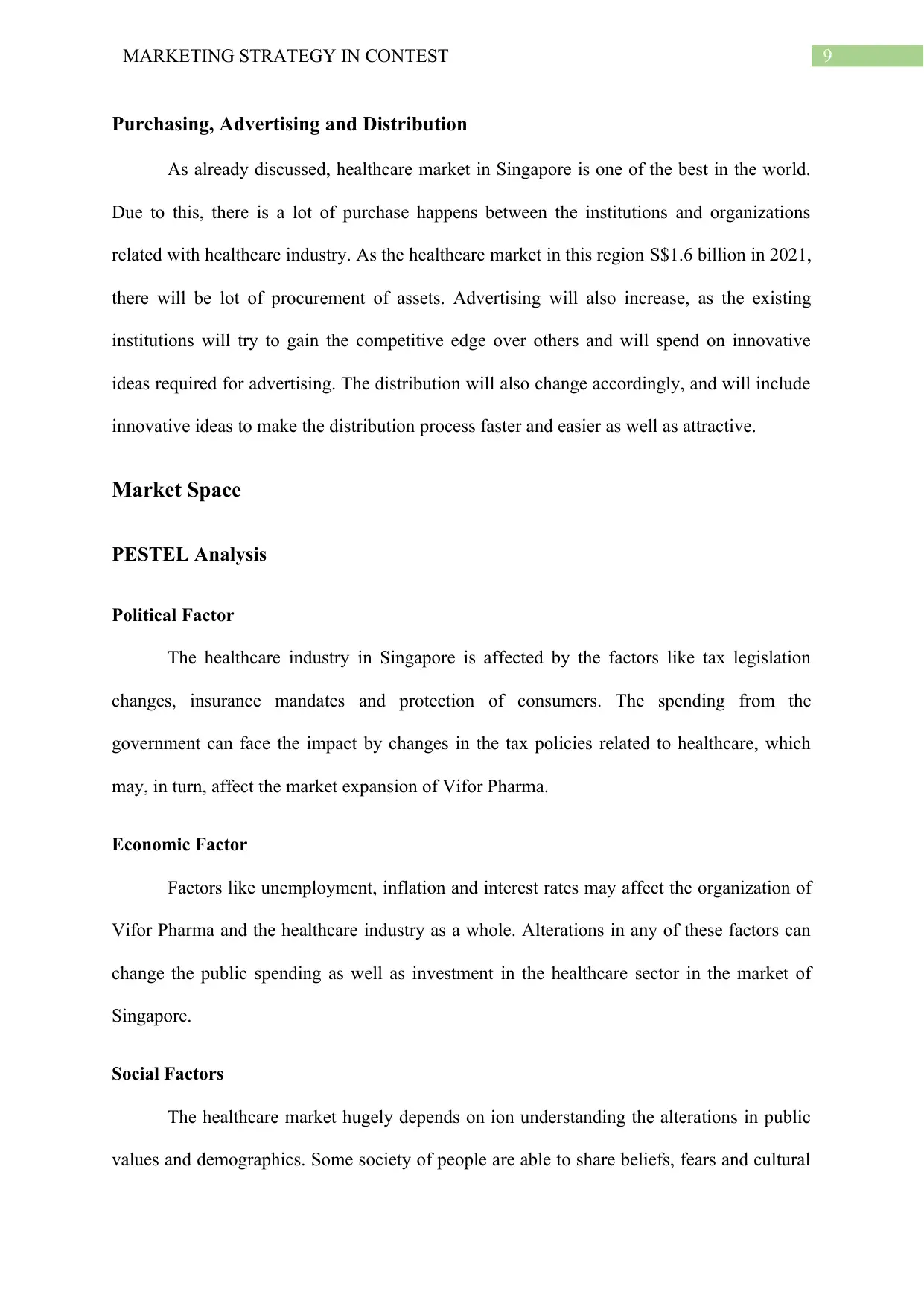
9MARKETING STRATEGY IN CONTEST
Purchasing, Advertising and Distribution
As already discussed, healthcare market in Singapore is one of the best in the world.
Due to this, there is a lot of purchase happens between the institutions and organizations
related with healthcare industry. As the healthcare market in this region S$1.6 billion in 2021,
there will be lot of procurement of assets. Advertising will also increase, as the existing
institutions will try to gain the competitive edge over others and will spend on innovative
ideas required for advertising. The distribution will also change accordingly, and will include
innovative ideas to make the distribution process faster and easier as well as attractive.
Market Space
PESTEL Analysis
Political Factor
The healthcare industry in Singapore is affected by the factors like tax legislation
changes, insurance mandates and protection of consumers. The spending from the
government can face the impact by changes in the tax policies related to healthcare, which
may, in turn, affect the market expansion of Vifor Pharma.
Economic Factor
Factors like unemployment, inflation and interest rates may affect the organization of
Vifor Pharma and the healthcare industry as a whole. Alterations in any of these factors can
change the public spending as well as investment in the healthcare sector in the market of
Singapore.
Social Factors
The healthcare market hugely depends on ion understanding the alterations in public
values and demographics. Some society of people are able to share beliefs, fears and cultural
Purchasing, Advertising and Distribution
As already discussed, healthcare market in Singapore is one of the best in the world.
Due to this, there is a lot of purchase happens between the institutions and organizations
related with healthcare industry. As the healthcare market in this region S$1.6 billion in 2021,
there will be lot of procurement of assets. Advertising will also increase, as the existing
institutions will try to gain the competitive edge over others and will spend on innovative
ideas required for advertising. The distribution will also change accordingly, and will include
innovative ideas to make the distribution process faster and easier as well as attractive.
Market Space
PESTEL Analysis
Political Factor
The healthcare industry in Singapore is affected by the factors like tax legislation
changes, insurance mandates and protection of consumers. The spending from the
government can face the impact by changes in the tax policies related to healthcare, which
may, in turn, affect the market expansion of Vifor Pharma.
Economic Factor
Factors like unemployment, inflation and interest rates may affect the organization of
Vifor Pharma and the healthcare industry as a whole. Alterations in any of these factors can
change the public spending as well as investment in the healthcare sector in the market of
Singapore.
Social Factors
The healthcare market hugely depends on ion understanding the alterations in public
values and demographics. Some society of people are able to share beliefs, fears and cultural
Paraphrase This Document
Need a fresh take? Get an instant paraphrase of this document with our AI Paraphraser
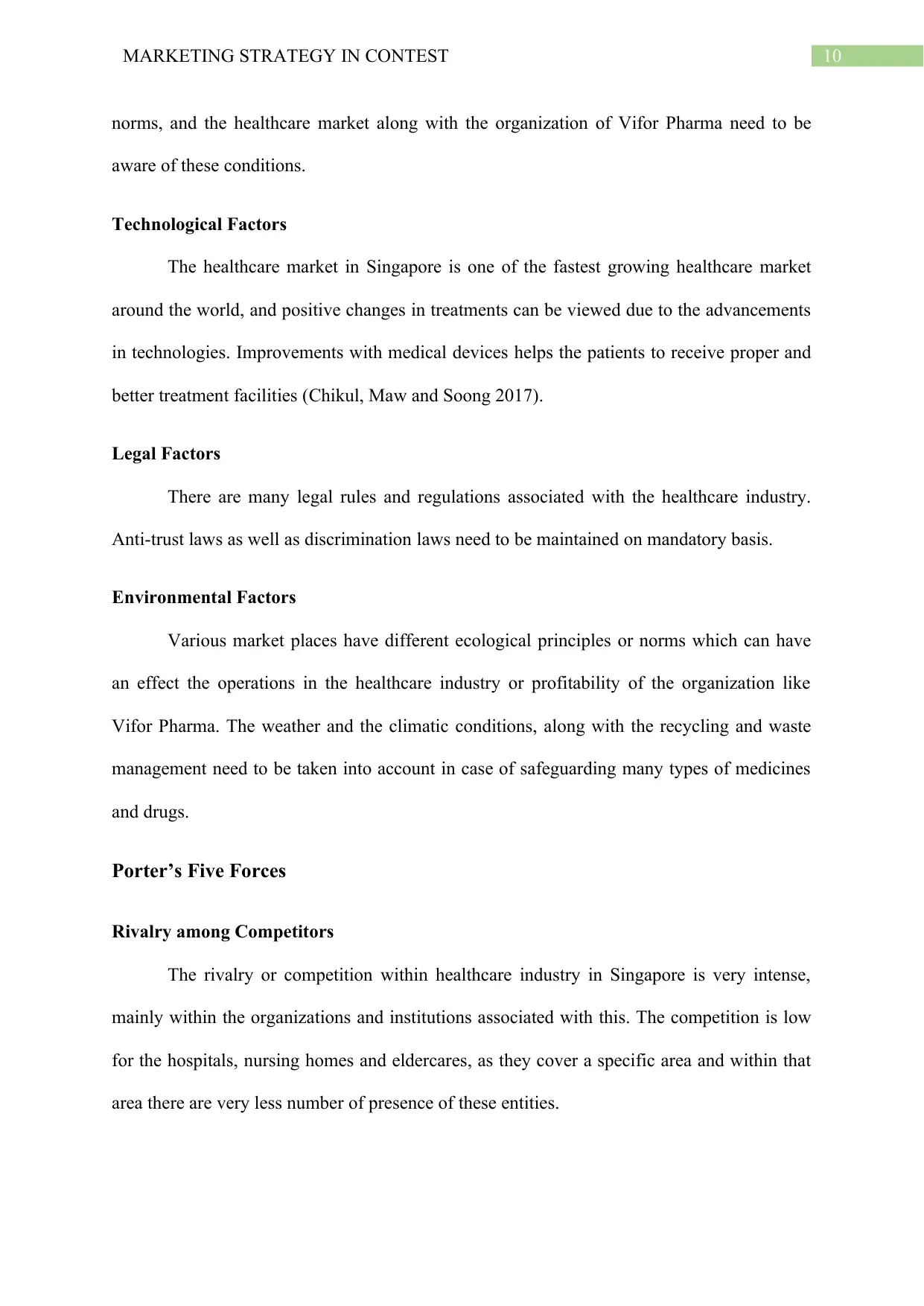
10MARKETING STRATEGY IN CONTEST
norms, and the healthcare market along with the organization of Vifor Pharma need to be
aware of these conditions.
Technological Factors
The healthcare market in Singapore is one of the fastest growing healthcare market
around the world, and positive changes in treatments can be viewed due to the advancements
in technologies. Improvements with medical devices helps the patients to receive proper and
better treatment facilities (Chikul, Maw and Soong 2017).
Legal Factors
There are many legal rules and regulations associated with the healthcare industry.
Anti-trust laws as well as discrimination laws need to be maintained on mandatory basis.
Environmental Factors
Various market places have different ecological principles or norms which can have
an effect the operations in the healthcare industry or profitability of the organization like
Vifor Pharma. The weather and the climatic conditions, along with the recycling and waste
management need to be taken into account in case of safeguarding many types of medicines
and drugs.
Porter’s Five Forces
Rivalry among Competitors
The rivalry or competition within healthcare industry in Singapore is very intense,
mainly within the organizations and institutions associated with this. The competition is low
for the hospitals, nursing homes and eldercares, as they cover a specific area and within that
area there are very less number of presence of these entities.
norms, and the healthcare market along with the organization of Vifor Pharma need to be
aware of these conditions.
Technological Factors
The healthcare market in Singapore is one of the fastest growing healthcare market
around the world, and positive changes in treatments can be viewed due to the advancements
in technologies. Improvements with medical devices helps the patients to receive proper and
better treatment facilities (Chikul, Maw and Soong 2017).
Legal Factors
There are many legal rules and regulations associated with the healthcare industry.
Anti-trust laws as well as discrimination laws need to be maintained on mandatory basis.
Environmental Factors
Various market places have different ecological principles or norms which can have
an effect the operations in the healthcare industry or profitability of the organization like
Vifor Pharma. The weather and the climatic conditions, along with the recycling and waste
management need to be taken into account in case of safeguarding many types of medicines
and drugs.
Porter’s Five Forces
Rivalry among Competitors
The rivalry or competition within healthcare industry in Singapore is very intense,
mainly within the organizations and institutions associated with this. The competition is low
for the hospitals, nursing homes and eldercares, as they cover a specific area and within that
area there are very less number of presence of these entities.
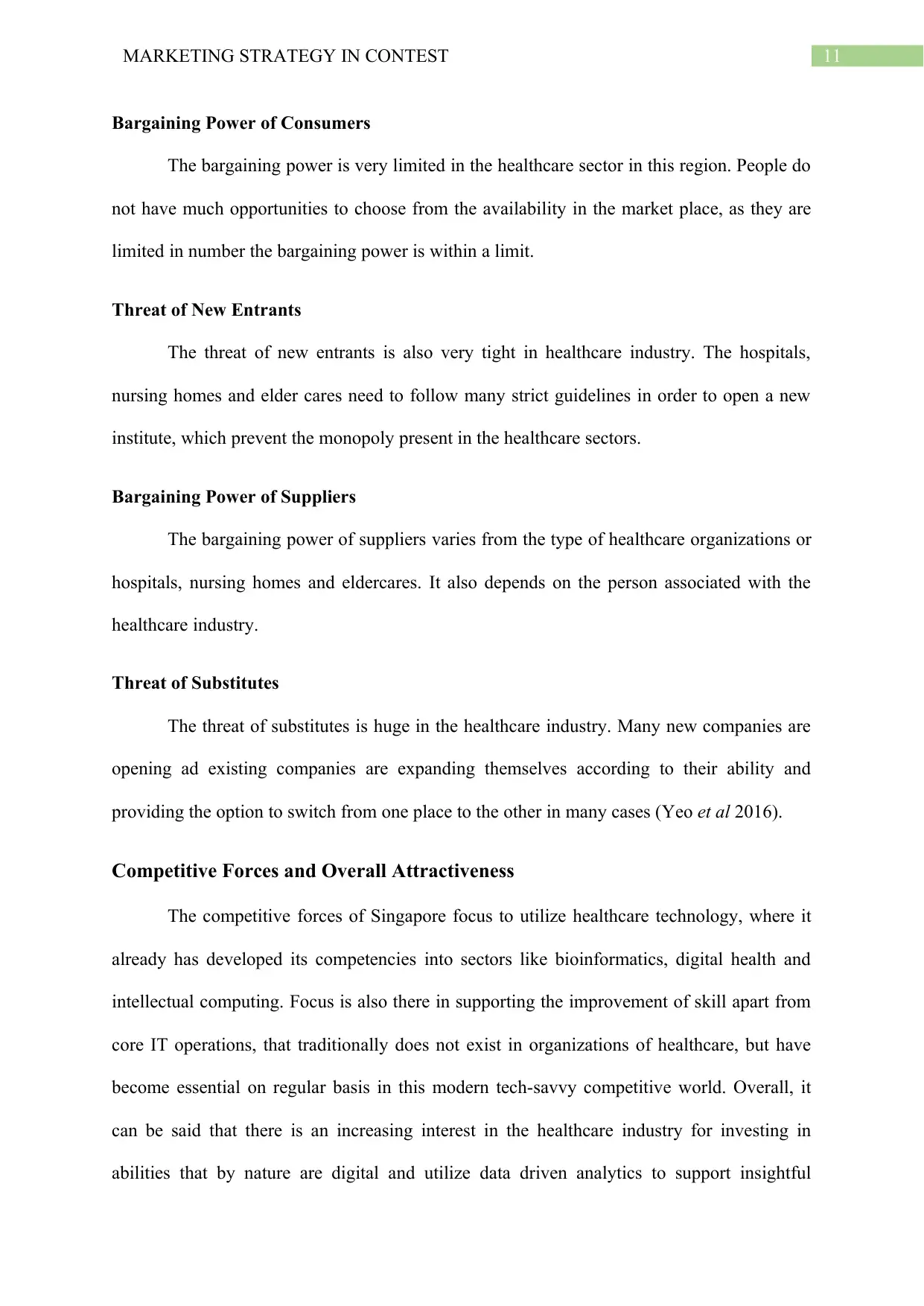
11MARKETING STRATEGY IN CONTEST
Bargaining Power of Consumers
The bargaining power is very limited in the healthcare sector in this region. People do
not have much opportunities to choose from the availability in the market place, as they are
limited in number the bargaining power is within a limit.
Threat of New Entrants
The threat of new entrants is also very tight in healthcare industry. The hospitals,
nursing homes and elder cares need to follow many strict guidelines in order to open a new
institute, which prevent the monopoly present in the healthcare sectors.
Bargaining Power of Suppliers
The bargaining power of suppliers varies from the type of healthcare organizations or
hospitals, nursing homes and eldercares. It also depends on the person associated with the
healthcare industry.
Threat of Substitutes
The threat of substitutes is huge in the healthcare industry. Many new companies are
opening ad existing companies are expanding themselves according to their ability and
providing the option to switch from one place to the other in many cases (Yeo et al 2016).
Competitive Forces and Overall Attractiveness
The competitive forces of Singapore focus to utilize healthcare technology, where it
already has developed its competencies into sectors like bioinformatics, digital health and
intellectual computing. Focus is also there in supporting the improvement of skill apart from
core IT operations, that traditionally does not exist in organizations of healthcare, but have
become essential on regular basis in this modern tech-savvy competitive world. Overall, it
can be said that there is an increasing interest in the healthcare industry for investing in
abilities that by nature are digital and utilize data driven analytics to support insightful
Bargaining Power of Consumers
The bargaining power is very limited in the healthcare sector in this region. People do
not have much opportunities to choose from the availability in the market place, as they are
limited in number the bargaining power is within a limit.
Threat of New Entrants
The threat of new entrants is also very tight in healthcare industry. The hospitals,
nursing homes and elder cares need to follow many strict guidelines in order to open a new
institute, which prevent the monopoly present in the healthcare sectors.
Bargaining Power of Suppliers
The bargaining power of suppliers varies from the type of healthcare organizations or
hospitals, nursing homes and eldercares. It also depends on the person associated with the
healthcare industry.
Threat of Substitutes
The threat of substitutes is huge in the healthcare industry. Many new companies are
opening ad existing companies are expanding themselves according to their ability and
providing the option to switch from one place to the other in many cases (Yeo et al 2016).
Competitive Forces and Overall Attractiveness
The competitive forces of Singapore focus to utilize healthcare technology, where it
already has developed its competencies into sectors like bioinformatics, digital health and
intellectual computing. Focus is also there in supporting the improvement of skill apart from
core IT operations, that traditionally does not exist in organizations of healthcare, but have
become essential on regular basis in this modern tech-savvy competitive world. Overall, it
can be said that there is an increasing interest in the healthcare industry for investing in
abilities that by nature are digital and utilize data driven analytics to support insightful
⊘ This is a preview!⊘
Do you want full access?
Subscribe today to unlock all pages.

Trusted by 1+ million students worldwide
1 out of 16
Related Documents
Your All-in-One AI-Powered Toolkit for Academic Success.
+13062052269
info@desklib.com
Available 24*7 on WhatsApp / Email
![[object Object]](/_next/static/media/star-bottom.7253800d.svg)
Unlock your academic potential
Copyright © 2020–2025 A2Z Services. All Rights Reserved. Developed and managed by ZUCOL.




